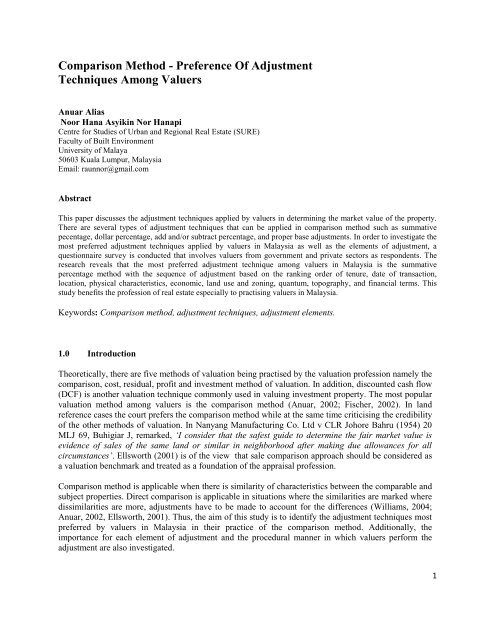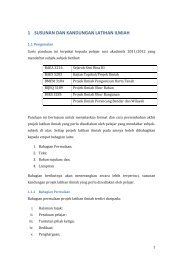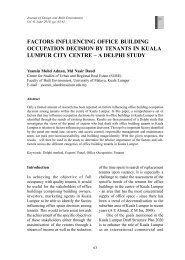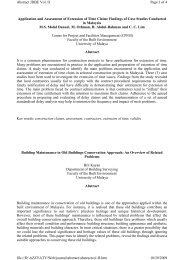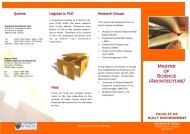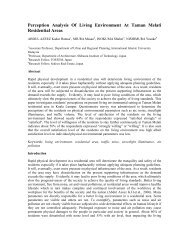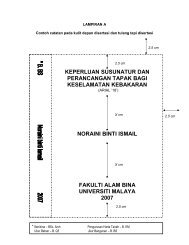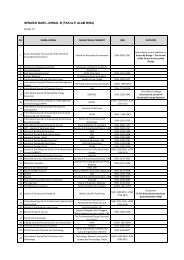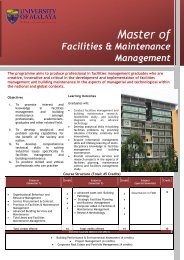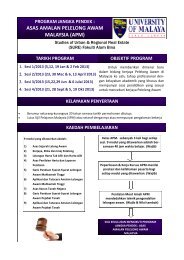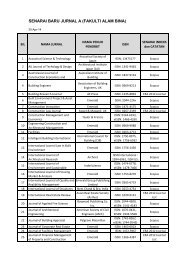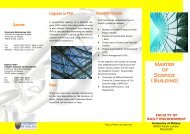comparison method - Faculty of Built Environment
comparison method - Faculty of Built Environment
comparison method - Faculty of Built Environment
Create successful ePaper yourself
Turn your PDF publications into a flip-book with our unique Google optimized e-Paper software.
Comparison Method - Preference Of Adjustment<br />
Techniques Among Valuers<br />
Anuar Alias<br />
Noor Hana Asyikin Nor Hanapi<br />
Centre for Studies <strong>of</strong> Urban and Regional Real Estate (SURE)<br />
<strong>Faculty</strong> <strong>of</strong> <strong>Built</strong> <strong>Environment</strong><br />
University <strong>of</strong> Malaya<br />
50603 Kuala Lumpur, Malaysia<br />
Email: raunnor@gmail.com<br />
Abstract<br />
This paper discusses the adjustment techniques applied by valuers in determining the market value <strong>of</strong> the property.<br />
There are several types <strong>of</strong> adjustment techniques that can be applied in <strong>comparison</strong> <strong>method</strong> such as summative<br />
pecentage, dollar percentage, add and/or subtract percentage, and proper base adjustments. In order to investigate the<br />
most preferred adjustment techniques applied by valuers in Malaysia as well as the elements <strong>of</strong> adjustment, a<br />
questionnaire survey is conducted that involves valuers from government and private sectors as respondents. The<br />
research reveals that the most preferred adjustment technique among valuers in Malaysia is the summative<br />
percentage <strong>method</strong> with the sequence <strong>of</strong> adjustment based on the ranking order <strong>of</strong> tenure, date <strong>of</strong> transaction,<br />
location, physical characteristics, economic, land use and zoning, quantum, topography, and financial terms. This<br />
study benefits the pr<strong>of</strong>ession <strong>of</strong> real estate especially to practising valuers in Malaysia.<br />
Keywords: Comparison <strong>method</strong>, adjustment techniques, adjustment elements.<br />
1.0 Introduction<br />
Theoretically, there are five <strong>method</strong>s <strong>of</strong> valuation being practised by the valuation pr<strong>of</strong>ession namely the<br />
<strong>comparison</strong>, cost, residual, pr<strong>of</strong>it and investment <strong>method</strong> <strong>of</strong> valuation. In addition, discounted cash flow<br />
(DCF) is another valuation technique commonly used in valuing investment property. The most popular<br />
valuation <strong>method</strong> among valuers is the <strong>comparison</strong> <strong>method</strong> (Anuar, 2002; Fischer, 2002). In land<br />
reference cases the court prefers the <strong>comparison</strong> <strong>method</strong> while at the same time criticising the credibility<br />
<strong>of</strong> the other <strong>method</strong>s <strong>of</strong> valuation. In Nanyang Manufacturing Co. Ltd v CLR Johore Bahru (1954) 20<br />
MLJ 69, Buhigiar J, remarked, ‘I consider that the safest guide to determine the fair market value is<br />
evidence <strong>of</strong> sales <strong>of</strong> the same land or similar in neighborhood after making due allowances for all<br />
circumstances’. Ellsworth (2001) is <strong>of</strong> the view that sale <strong>comparison</strong> approach should be considered as<br />
a valuation benchmark and treated as a foundation <strong>of</strong> the appraisal pr<strong>of</strong>ession.<br />
Comparison <strong>method</strong> is applicable when there is similarity <strong>of</strong> characteristics between the comparable and<br />
subject properties. Direct <strong>comparison</strong> is applicable in situations where the similarities are marked where<br />
dissimilarities are more, adjustments have to be made to account for the differences (Williams, 2004;<br />
Anuar, 2002, Ellsworth, 2001). Thus, the aim <strong>of</strong> this study is to identify the adjustment techniques most<br />
preferred by valuers in Malaysia in their practice <strong>of</strong> the <strong>comparison</strong> <strong>method</strong>. Additionally, the<br />
importance for each element <strong>of</strong> adjustment and the procedural manner in which valuers perform the<br />
adjustment are also investigated.<br />
1
2.0 Background and Problems <strong>of</strong> Study<br />
In arriving at the market value, a subject property needs to be compared with an appropriate number <strong>of</strong><br />
comparable properties for the similarities and the dissimilarities. The types <strong>of</strong> properties that are<br />
amenable to the treatment by <strong>comparison</strong> <strong>method</strong> as suggested by various authors are residential<br />
(Rodgers, 2001; Dennis & Pinkowish, 2007), investment (Wincott, 2002), industrial (Ellsworth, 2001;<br />
2002), mining (Healy & Berquist, 2000), contaminated land (Patchin, 1999), vacant land (Guidry, 2003),<br />
telecommunication corridor (Bucaria & Kuls, 2002) and <strong>of</strong>fice properties (Wincott, 2001; Clendaniel,<br />
2005). Rodgers (2001) proposes that valuers can apply a systematic grid-adjustment process that<br />
employs specific percentage or dollar-amount adjustments, highlighting that this approach emphasises<br />
the individual comparable sales as the most meaningful units <strong>of</strong> <strong>comparison</strong> called „property-to-property<br />
<strong>comparison</strong>‟. Williams (2004) observes that adjustments for the numerous <strong>of</strong> dissimilarities between a<br />
subject property and its comparables can be made on a dollar or a percentage basis. If a comparable<br />
property is superior to the subject property to which it is being compared, then a negative or minus<br />
adjustment is made to take the comparable property from that superior position down to a equal level<br />
equal to the subject property. If a comparable property is inferior which it is being compared to the<br />
subject property, then a positive adjustment is made. The market itself determines whether the item is<br />
superior or inferior.<br />
For any given element, the adjustment quantum can be derived by using a paired data or “matched pair”<br />
technique, which measures the price difference between two recent transactions that are otherwise<br />
identical except for the element under consideration; the value difference between the two constitute the<br />
dollar or percentage adjustment for this element. Either dollar or percentage adjustments should result in<br />
the exact same adjusted sale price (Williams, 2004; Rodgers, 2001).<br />
Williams (2004) notes that the dollar adjustment for each element independently arises from the market<br />
as a result <strong>of</strong> reflecting the dissimilarities that affect value, and they are simply added together. The total<br />
<strong>of</strong> the adjustments is then added to or subtracted from the comparable‟s sale price to make the<br />
comparable equal to the subject as <strong>of</strong> the date <strong>of</strong> value. This is the principle <strong>of</strong> dollar adjusting.<br />
Percentage adjustments, however, are conducted differently on the basis <strong>of</strong> adjusting to make them<br />
equivalent to dollar adjustments. Several percentage adjustments should not be added together and then<br />
applied to adjust comparables sales. It would be technically and mathematically incorrect to add the<br />
adjustments because this does not result in moving from basis to basis. When percentage adjustments are<br />
applied, the result must be mathematically equal to dollar adjustment that is obtained separately from the<br />
market. Adding and subtracting the percentage adjustments gives an answer that is different from that<br />
derived by principle <strong>of</strong> adjusting using dollars. Williams (2004) concludes that the basis <strong>of</strong> adjusting the<br />
percentage can be used for all elements <strong>of</strong> <strong>comparison</strong> in the sales <strong>comparison</strong> approach, but it would be<br />
incorrect to simply add or subtract these adjustments and apply the sum to the comparable sale price.<br />
Stellmacher (1998) reports that valuers add and subtract percentage to arrive at a conclusion when<br />
multiple adjustments are involved, but views this procedure as flawed. Valuers should multiply<br />
percentage to arrive at a conclusion, although it is perfectly correct to add and subtract adjustments in<br />
dollar amounts. Based on the analysis by Stellmacher (1998), two <strong>method</strong>s <strong>of</strong> adjustments are add and<br />
subtract percentage and multiple percentage. Based on the analysis, the indicated value is different.<br />
Hodges (2007) states that no specific mathematical theory exists regarding the proper averaging <strong>of</strong><br />
percentages.<br />
2
From the above discussion, the problems encountered in applying <strong>comparison</strong> <strong>method</strong> in Malaysia are as<br />
follows:<br />
There is the current lack <strong>of</strong> data to guide valuers on the preferred technique <strong>of</strong><br />
adjustment to use, this made valuers uncertain about which technique is more<br />
appropriate to apply.<br />
The valuers are uncertain on which adjustment techniques are most appropriate to<br />
use.<br />
There is lack <strong>of</strong> empirical study to examine how valuers perform the technique and<br />
what are their preferred.<br />
Against the background <strong>of</strong> this situation, there is no data currently in terms <strong>of</strong> the<br />
valuers practise the adjustment on the techniques they prefer (if any)<br />
3.0 Objectives<br />
The specific objectives <strong>of</strong> this research are as follows:<br />
i. To examine the adjustment techniques used by valuers in Malaysia in their practice <strong>of</strong> the<br />
<strong>comparison</strong> <strong>method</strong>.<br />
ii. To determine the sequence for adjustment <strong>of</strong> elements in <strong>comparison</strong> <strong>method</strong>.<br />
iii. To explore the most preferred adjustment techniques by valuers in applying <strong>comparison</strong> <strong>method</strong>.<br />
4.0 Research Methodology<br />
This research has adopted a questionnaire survey <strong>method</strong> for data collection. To achieve the objectives,<br />
the research explores the perceptions <strong>of</strong> related parties on the issues <strong>of</strong> adjustment techniques and<br />
elements <strong>of</strong> adjustment in carrying out the valuation exercises by applying <strong>comparison</strong> <strong>method</strong>..<br />
Interviews were also carried out to strengthen the results.<br />
The questionnaire was divided into three main sections:<br />
<br />
Part A – respondent‟s background.<br />
Part B – views on the adjustment techniques and elements <strong>of</strong> adjustment in carrying out<br />
valuation by <strong>comparison</strong> <strong>method</strong>.<br />
Part C – perceptions on the most preferred adjustment techniques applied by valuers in<br />
Malaysia in carrying out the valuation by <strong>comparison</strong> <strong>method</strong>.<br />
The rationale for this particular format <strong>of</strong> the questionnaire design was so that views and perceptions <strong>of</strong><br />
valuers in Malaysia toward the most preferred adjustment techniques among valuers could be explored.<br />
To ensure the reliability <strong>of</strong> the questions, reliability tests were performed on the questionnaire and the<br />
results are as in Table 1. The overall value <strong>of</strong> above 0.6 for the Cronbach‟s Alpha shows that all variables<br />
had attained internal consistency and achieved high reliability scores based on scales developed by<br />
Sekaran (2000). Based on this theory, a variable that achieves a Cronbach‟s Alpha coefficient value <strong>of</strong><br />
more than 0.6 points is regarded as achieving high internal consistency and reliability. This suggests that<br />
the respective respondents were able to understand the questions in the questionnaires while the necessity<br />
<strong>of</strong> asking the questions was also confirmed.<br />
3
No. Variables No. <strong>of</strong><br />
Items<br />
Coefficient Value<br />
Cronbach’s Alpha<br />
1 Important <strong>of</strong> adjustment process in <strong>comparison</strong> <strong>method</strong> 1 0.7369<br />
2 Adjustment techniques available 3 0.7358<br />
3 Elements <strong>of</strong> adjustment 9 0.7406<br />
4 Sequence <strong>of</strong> adjustment for elements 9 0.7358<br />
5 The most preferred adjustment techniques 3 0.7350<br />
6 Overall 25 0.7314<br />
Table 1: Reliability Test<br />
5.0 Discussion <strong>of</strong> the Research Findings<br />
5.1 The Respondents’ Pr<strong>of</strong>iles<br />
The backgrounds <strong>of</strong> the respondents who took part in the survey are presented in Table 2.<br />
Characteristic Frequency (N) Percentage (%)<br />
Sector<br />
Valid Government Valuer 80 53<br />
Private Valuer 70 47<br />
Total 150 100<br />
Experience in Real Estate Valuation (Government Valuer)<br />
Valid < 6 years 10 12.5<br />
16 – 10 years 40 50<br />
11 – 15 years 15 19<br />
16 – 20 years 10 12.5<br />
> 20 years 5 6<br />
Total 80 100<br />
Experience in Real Estate Valuation (Private Valuer)<br />
Valid < 6 years 12 17<br />
16 – 10 years 40 57<br />
11 – 15 years 11 16<br />
16 – 20 years 5 7<br />
> 20 years 2 3<br />
Total 70 100<br />
Table 2: The Background <strong>of</strong> the Respondents<br />
5.2 Opinion on Comparison Method<br />
Some 60% <strong>of</strong> the public valuers viewed <strong>comparison</strong> <strong>method</strong> as the best among the <strong>method</strong>s <strong>of</strong> valuation<br />
while 57% <strong>of</strong> private valuers shared the same view. It is evident that a large number <strong>of</strong> respondents are in<br />
mutual agreement to consider that the best <strong>method</strong> is the <strong>comparison</strong> <strong>method</strong>. This result are consistent<br />
with the view <strong>of</strong> Ellsworth (2001), Rodgers (2001) and Williams (2004).<br />
4
Figure 1: Opinion on Comparison Method<br />
5.3 Importance <strong>of</strong> Adjustment Process<br />
Figure 2 shows that 53% <strong>of</strong> private valuers agreed on the importance <strong>of</strong> adjustment process while only<br />
23% <strong>of</strong> government did. Thus, this result shows that valuers from both sectors were agreed that<br />
adjustment process is important process in applying <strong>comparison</strong> <strong>method</strong>.<br />
Figure 2: Adjustment process<br />
5.4 Preference <strong>of</strong> Adjustment Techniques<br />
Figures 3 showed that a majority <strong>of</strong> the respondents (64% from private; 53% from public sector) were<br />
agreed that summative percentage adjustments were most practised in Malaysia while Figures 4 showed<br />
that majority <strong>of</strong> the respondents (77% from private and 67% from public) were agreed that base<br />
percentage is also being practised as an adjustment technique in <strong>comparison</strong> <strong>method</strong>. This is because the<br />
basic adjustments for base percentage are more alike summative percentage. Williams (2004) states that<br />
either summative or base percentage techniques, both are represented by the percentage on its<br />
application for adjustment process. Attention must be taken to identify the correct base to be adjusted.<br />
For example, a corner lot and first layer site for commercial commands a higher price than an interior<br />
site.<br />
The principle for a base adjusting is as follows:<br />
New Base ($) – Original Base ($) = Adjustment<br />
($)<br />
5
The bases may be identified by pairing two different comparables. If two properties are basically equal<br />
except for one feature, the adjustment is implemented. Assume the sale <strong>of</strong> a property one year ago was for<br />
$100,000 and a current sale for the same property now is $120,000. The adjustment is calculated by<br />
applying the base adjustment concept as follows:<br />
New Base ($) – Original Base ($) = Adjustment<br />
or<br />
($)<br />
$120,000 - $100,000 = $20,000<br />
The adjustment for the change in market conditions is $20,000 for a one-year period. The direction <strong>of</strong> the<br />
movement from the original base shows that the market is getting better and the adjustment is positive.<br />
Figure 3: Summative percentage.<br />
Figure 4: Base percentage.<br />
Figure 5 illustrates that 90% <strong>of</strong> respondents from private sector and 77% respondents from government<br />
sector were in neutral opinion on dollar adjustments as an adjustment technique. In this regard, only a<br />
small percentage i.e. 23% from government sector and 10% from private sector were agreed on<br />
application <strong>of</strong> dollar adjustment in Malaysia.<br />
Figure 5: Dollar Adjustment<br />
6
5.5 Analysis on Sequences <strong>of</strong> Elements for Adjustment Process in Comparison Method<br />
Table 3 shows the descriptive statistics on what the valuers perceive as the sequences <strong>of</strong> elements for<br />
adjustment process in <strong>comparison</strong> <strong>method</strong>. It was evident that the valuers in Malaysia considered the<br />
„tenure‟ as the most important factor or first rank to adjust in applying <strong>comparison</strong> <strong>method</strong> (mean=2.64).<br />
Basically, in Malaysia there are two types <strong>of</strong> tenure namely freehold and leasehold interests. Theoretically,<br />
the best comparable properties were the properties that have the same tenure as the subject property.<br />
Among other significant factors that the valuers attributed as the elements for adjustment are; the<br />
transaction and financing terms; transaction date; location and physical characteristics; economic<br />
characteristics; land use or zoning; size; and topography. In particular, all the suggested factors were<br />
perceived as agreeable to the respondents as the elements for adjustment process in <strong>comparison</strong> <strong>method</strong><br />
evident from the mean values <strong>of</strong> 2.43 to 2.58 points.<br />
Variables<br />
Descriptive Statistics<br />
N Min Max Mean Standard<br />
Deviation<br />
a) Tenure 150 1 3 2.64 .529 1<br />
b) Date <strong>of</strong> transaction 150 1 3 2.58 .585 2<br />
c) Location 150 1 3 2.56 .568 3<br />
d) Physical characteristics 150 1 3 2.52 .621 4<br />
e) Economy condition 150 1 3 2.52 .612 5<br />
f) Land use / zoning 150 1 3 2.49 .630 6<br />
g) Quantum /size 150 1 3 2.48 .612 7<br />
h) Topography and terrain 150 1 3 2.46 .671 8<br />
i) Financial terms 150 1 3 2.43 .656 9<br />
Valid N (listwise) 150<br />
Legend: 1= Disagree, 2= Not Sure, 3= Agree<br />
Table 3: Descriptive Statistics on the Sequence <strong>of</strong> Adjustment Elements<br />
Ranking<br />
Table 3 also shows that the respondents were strongly agreed that the transaction date is an element to be<br />
adjusted in <strong>comparison</strong> <strong>method</strong>. This finding confirmed the research by Rodgers (2001) that transaction<br />
date is an important element that needs to be adjusted. Location, by region and the street level, is a major<br />
factor that effects property value. Rodgers (2001); Anuar (2002) and Fischer (2002) mentioned that<br />
location is a major factor effecting property value. Both private and public valuers agreed that location is<br />
one the major element <strong>of</strong> adjustment which they ranked as third position and followed by physical<br />
characteristic. The physical characteristics are including defects, furnishes, and the level <strong>of</strong> maintenance<br />
works.<br />
Economic characteristic is referring to economic life span <strong>of</strong> the building. Generally, life span <strong>of</strong> a<br />
building was about 60 years. Besides that, in valuing property, zoning or land uses <strong>of</strong> the property also<br />
need to take into consideration. In Malaysia‟s context, there are three types <strong>of</strong> zoning namely residential,<br />
commercial and industrial. The market values for properties are influenced by zoning. This study showed<br />
7
that adjustment should also be considered for element <strong>of</strong> size <strong>of</strong> the property. On the other hand,<br />
topography/terrain is also considered as one <strong>of</strong> the elements for adjustment in <strong>comparison</strong> <strong>method</strong>.<br />
Other elements for adjustment are very subjective to be identified and are based on case by case basis. It<br />
can be the prices <strong>of</strong> the property together with other fees such as legal fees and stamp duty fee. Financing<br />
terms refer to the term <strong>of</strong> the loan or payment period. In Malaysia, financing terms was not really<br />
considered as the elements <strong>of</strong> adjustments since this information is confidential and not easily available.<br />
From the results, it clearly shows that the financial term was the last ranking in the sequence <strong>of</strong><br />
adjustment.<br />
6.0 Conclusion<br />
Most <strong>of</strong> the findings were consistent with the findings <strong>of</strong> the previous studies. Practising valuers in<br />
Malaysia were agreed with Ellsworth (2001) that <strong>comparison</strong> <strong>method</strong> is the best <strong>method</strong> in determining the<br />
market value <strong>of</strong> property. Based on the analysis, summative percentage, base percentage and dollar<br />
adjustment are the techniques that are applied by Malaysians‟ valuers in <strong>comparison</strong> <strong>method</strong>. However,<br />
summative percentage is the most preferred adjustment technique in applying the <strong>comparison</strong> <strong>method</strong>.<br />
Generally, on the elements <strong>of</strong> adjustment such as tenure, location, size, zoning, physical characteristics are<br />
adjusted based on the sequence <strong>of</strong> order. Tenure is the highest order or the first ranking that being adjusted<br />
in applying <strong>comparison</strong> <strong>method</strong>.<br />
REFERENCES<br />
Anuar, A. (2002), Valuation Techniques: An Overview <strong>of</strong> Current Practice in Malaysia, Paper for MTCP Program,<br />
INSPEN, Unpublished.<br />
Bucaria, C. P. and Kuhs, R. G. (2002), Fiber Optic Communication Corridor Right-<strong>of</strong>-Way Valuation<br />
Methodology, The Appraisal Journal, April 2002, pp 136-147.<br />
Clendaniel, J. H. (2005), Telecommunications Infrastructure Facilities, The Appraisal Journal, Summer 2005, pp<br />
278-287.<br />
Dennis, M. D. and Pinkowish, T. J. (2007), Residential Mortgage Lending: Principles and Practices, South-<br />
Western.<br />
Ellsworth, R. (2001), The Sales Comparison Approach and the Appraisal <strong>of</strong> Complete Facilities, The Appraisal<br />
Journal, July 2001, pp 266-269.<br />
Ellsworth, R. (2002), Industrial Facility Valuation: Electrical Generating Projects, The Appraisal Journals, January<br />
2002, pp 34-38.<br />
Fischer, D. (2002), Property Valuation Methodology, Black An Press.<br />
Guidry, K. A. (2003), Appraisal Assignments Involving Endangered Species, The Appraisal Journal, January<br />
2003, pp 98-102.<br />
Healy, M. J. and Bergquist, K. (2001), The Sales Comparison Approach and Timberland Valuation, The<br />
Appraisal Journal, pp 587-595.<br />
Hodges, M. B. (2007), Three Approaches? , The Appraisal Journal, Winter 2007, pp 34-44.<br />
Patchin, P.J. (1999), Contaminated Properties and the Sales Comparison Approach, The Appraisal Journal,<br />
July 1999, pp 402-409.<br />
Rodgers, T. (2001), Property-to-Property Comparison, The Appraisal Journal, January 2001, pp 64-67.<br />
Sekaran U., (2000), Research Methods for Business: A Skill Building Approach, 4 rd Ed., New York: John Wiley &<br />
Sons Inc.<br />
8
Stellmacher, H. B. (1998), An Easy Method for Developing Accurate Land Comparables Adjustments, The Appraisal<br />
Journal, July 2008, pp 316-319.<br />
Williams, T. P. (2004), Base Adjusting in the Sales Comparison Approach, The Appraisal Journal, Spring<br />
2004, pp 155-162.<br />
Wincott, D. R. (2001), The Myth <strong>of</strong> Three Independent Approaches to Value, Real Estate Issues, Summer 2001, pp<br />
16-21.<br />
Wincott, D. R. (2002), A Primer on Comparable Sale Confirmation, The Appraisal Journal, July 2002, pp 274-282.<br />
9


